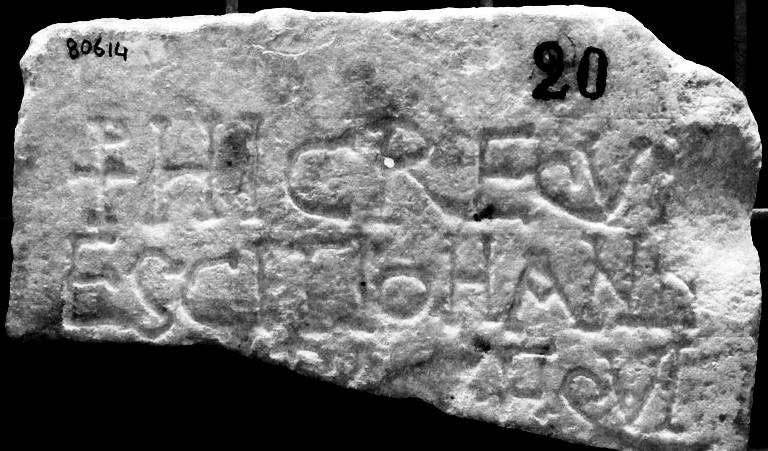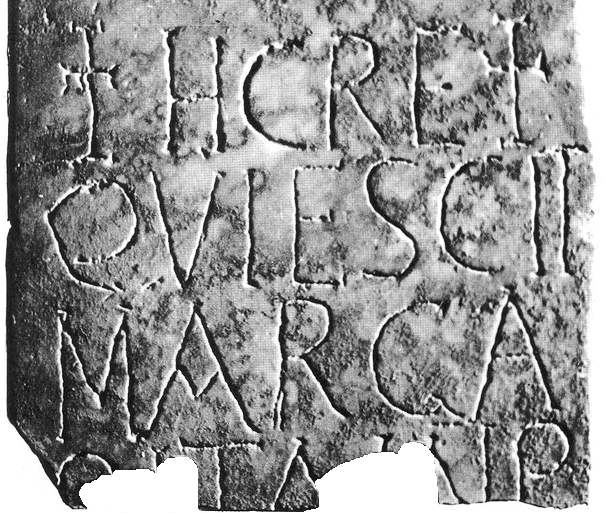Christianity
The martyrs Secondianus, Marcellianus, and Verianus are mentioned in relation to Centumcellae during the reign of Decius (249-251 AD), but the story is confused and other places are mentioned.
Eadem hora Nuntiatum est Decio Caesari, quia alii duo Scholastici similes eius essent in Custodia. Et dixit Caesar Decius cum furore, In exilio deportentur. Valerianus Praefectus dixit ad Decium Caesarem, Quo praecipit pietas vestra? Decius Caesar dixit, Deducantur Centumcellis, et tradantur Promoto Consulari, et coarctentur offerre diis sacrificia. Eadem vero die ducti sunt a militibus quinquaginta, et traditi sunt Quarto Promoto Consulari. Eadem hora acceptos misit eos in custodia cum triginta militibus, vinctos catenis, quia hoc praeceptum est: Non merentur vivere, si non sacrificaverint diis secundum consuetudinem antiquam. Et cum hoc dixisset Promotus Consularis Tusciae, alia die iussit, sibi in civitate Centumcellae, in foro tribunal parari: et sedens in tribunali, iussit ante se, in conspectu omnium et magistratuum, simulacrum Saturni et tripoda deferri: et praecepit Secundianum et Marcellianum et Virianum adduci. ... Promotus Consularis Tusciae, iracundia plenus, dedit in eis sententiam, ut capite truncarentur, et corpora eorum iactarentur in mari. At the same hour Decius Caesar was informed that two other teachers like Secundianus were in prison. And Caesar Decius said with fury that they must be sent in exile. Valerianus the Prefect said to Decius Caesar: 'What does your sense of duty command?' Decius Caesar said: 'They must be taken to Centumcellae, and handed over to Promotus of consular rank, and forced to offer sacrifices to the gods.' On the same day they were taken away by fifty soldiers, and handed over to Quartus Promotus of consular rank. At the same hour he received them and sent them to prison with thirty soldiers, tied with chains, because this had been ordered: 'They do not deserve to live, if they will not have sacrificed to the gods according to the old custom.' And because he had said this, Promotus of consular rank of Tuscia, ordered the next day that the judgement platform be brought in readiness for him in the city of Centumcellae, on the forum. And seated on the platform, he ordered that a statue of Saturn and a tripod be placed in front of him, in full view for all and for the magistrates. And he ordered that Secundianus and Marcellianus and Virianus be brought forward. ... Promotus of consular rank of Tuscia, full of anger, passed sentence on them, that they be decapitated, and their bodies thrown in the sea. Acta Sanctorum, June 1, t. 1, 36-37. Trebonianus Gallus (251-253 AD) sent the bishop of Rome, Cornelius, in exile to Centumcellae. Here he received a letter of encouragement by Cyprianus. He died in 253, apparently as a martyr and decapitated. In 283 his body was taken to a crypt near the catacomb of Saint Callixtus in Rome.
Cornelius episcopus Centumcellis pulsus est et ibidem scriptam epistolam de sua confirmatione missam accepit a Cypriano, quam Cyprianus in carcerem scripsit, et de Celerino lectore. Then Cornelius, the bishop, was banished to Centumcellae and there he received a letter written and sent for his encouragement by Cyprian, which Cyprian wrote in prison to tell of Celerinus, the lector ('reader'). Liber Pontificalis, XXII Cornelius. See also Acta Sanctorum, September 14, t. 4, 147. During the reign of Diocletianus (284-305 AD) the martyr Firmina is mentioned in relation to Centumcellae, but again the story is confused, mentioning also the city of Amelia. She is said to have calmed a storm during a sea voyage to Centumcellae and to have lived for some time in a grotto near the harbour, at the spot of the present Forte Michelangelo. A statue of the saint is near the fort, and every year another statue is carried through the city in a procession, on April 28. For 303 AD a martyr named Flavianus is documented, beheaded in Centumcellae with his entire household.
The procession of Firmina. Her statue is in the background.
Photo: civitavecchia.portmobility.it.Shortly after the Edict of Milan, in 314 AD, a bishop of Centumcellae, Epictetus, is present at the Council of Arles. A bishop with the same name is documented in 350 or 355 AD. Between 361 and 365 AD another Flavianus, praefectus Urbi, opposed Julianus Apostata, was sent into exile to Aquae Tauri and executed there. On various spots in the city Christian funerary inscriptions from the 5th and 6th century have been found.

☧ HIC REQVI
ESCIT IOHANN
[es i]N PACE QVI
[vixit ann(os) ---]
Christian funerary inscription.
6th century.
EDR079782.
✟ H(i)C RE ✟
QVIESCIT
MARGA
RITA IN P
[ace ---]
Christian funerary inscription.
450-550 AD.
EDR079783.In 828 AD the city was captured and destroyed by the Saracenes. In 854 AD a new settlement was built by pope Leo IV, far from the coast. It was called Leopolis or still Centumcellae, eventually Cencelle.